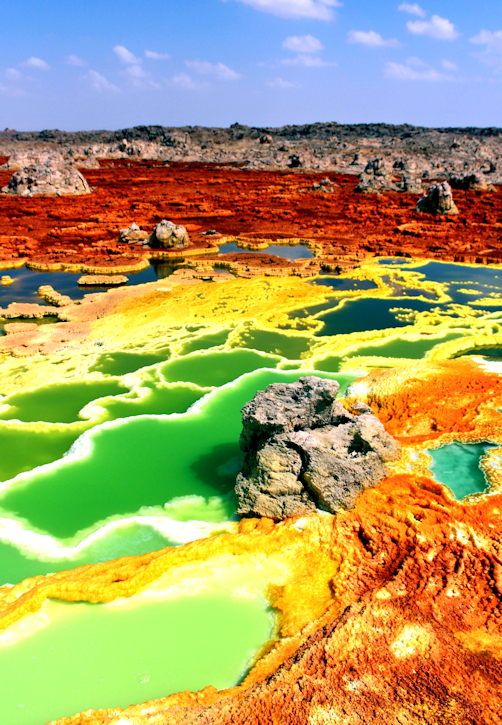Sickly green pools rimmed with lime green salt deposits. Vivid red crusts and bilious yellow mineral deposits bulge towards the horizon as if trying to escape the cruel terrain. Here, the water reaches a pH rivaling battery acid and is ten times as salty as seawater. This is not a description of a planet in the upcoming Star Wars franchise – no. Welcome to Dallol, Ethiopia.

Dallol is the site of the Earth’s lowest land volcano, housing a series of hot springs in its craters. Due to the volcanic magma beneath the springs, the groundwater feeding these springs is superheated and dissolves minerals along its journey to the surface. The natural process of water cycling in the volcanic basalt results in pools of water that are saturated with salt, lacking oxygen, and hyper-concentrated in minerals like iron and sulfur that give the pools their unearthly color. This exceptional environment has earned a designation by scientists as a poly-extreme environment. Poly-extreme environments are areas on Earth where more than one condition (e.g salinity, temperature, mineral concentration) exceeds the levels which typically support biological organisms. Habitats that challenge survival are excellent natural laboratories to seek life that pushes the boundaries of biology. Places such as the Dallol springs provide tantalizing clues as to how an organism may have originated on our early planet or in an extra-terrestrial environment.
The question of life in the uninhabitable Dallol seemed settled when a group of Italian researchers claimed to have found life in the scalding springs. Their conclusions were based on analysis of mineral chimneys extruded from the pools, where they found tiny amounts of DNA and what appear to be ultra-small organisms under a microscope. However, more recent work by another group challenges their findings, suggesting that no sign of life can be found in the brutal conditions of Dallol’s brine pools, and that DNA found in the area is likely from archaea that live in less severe conditions surrounding the pools. Clearly addressing the work of the other group studying the area, these scientists caution that some mineral precipitates in the area are biomorphic, meaning that the deposits look like organisms.
It is not unheard of for two different groups of researchers to come to different conclusions regarding the scientific evidence at hand, particularly in challenging research conditions such as those found in Dallol. Scientists hoping to uncover signs of life in Dallol need to work in blistering hot conditions where any misstep could spell grave injury.
In spite of the controversial nature of the living contents of the springs, these studies seeking the limits of life inform the self-correcting nature and rigor of the scientific process. Let’s face it: scientists sometimes get it wrong. However, the process of scientific discovery leads slowly, meanderingly and inexorably towards reality. The pioneer studies of life in Dallol’s craters serve as a warning to proceed with caution and rigor in interpreting life on Earth and beyond.
Peer edited by Yogitha Chareddy